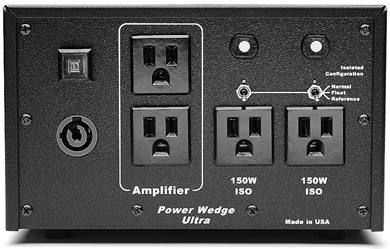API’s 112 Power Wedge Ultra Line Conditioner
| API’s 112 Power Wedge Ultra Line Conditioner |
| Testing a Tweak’s Effectiveness |
| Mike Silverton |
| 27 April 1999 |
For hard information, contact
Audio Power Industries
2624 S. Rouselle St.
Santa Ana, CA 92707
Phone: 714 545 9495
Fax: 714 545 4607
Address: www.audiopower.com
Email: info@audiopower.com
When I reported on the joys of cohabitation with my Mark Levinson No.33H mono amps, I wondered whether the 33H’s internal regeneration of AC house juice hasn’t a lot to do with its audible virtues. Now, were I a genuine hardware reviewer, I’d not have asked so naive a question in view of the circumstance under which I wrote about the 33H: on board simultaneously was and is a line conditioner for my Levinson No.39 CD player. Because one listens to a totality, it’s quite useless to sit in one’s illusory music space and isolate and judge in one’s mind the contributions of its parts. Nevertheless, I was inclined to perceive the line conditioner, an Audio Power Industries Model 112 Power Wedge Ultra, as the right move to have made. The huge and marvelous Levinsons would not profit from further AC mains isolation. Madrigal Audio’s promotional pamphlet mentions internal isolation for the relatively diminutive No.39 single-chassis CD player’s “clock” function. Simply from the standpoint of size, it appeared to me that whatever the No.39 does to distance itself from out-of-the-wall uglies might profit from an upstream assist.
The test of an assumption couldn’t be simpler. I’m using as peripherals to the API 112 Power Wedge Ultra (hereafter Ultra) an API PL 313 power cord from player to Ultra and a heavier-gauge API PL 311 power cord from Ultra to wall. (The separately purchased, upgrade 311 power cord comes with a lock-in-place Neutrik connector I’ve not elsewhere seen. API ships its Ultra line with a quotidian line cord likewise fitted. Audiophiles are more likely to be familiar with Neutrik as the principal manufacturer of high-quality male and female terminations for balanced interconnects.) I’ve an idle 313 power cord on hand. I propose to remove the 313 connecting player to Ultra and replace it with the free 313, which I’ll plug directly into a wall outlet. And sit down and listen and try to decide, Ultra thus removed, whether I hear a difference, and if I do, the try to determine whether that difference is for better or worse.
The first disc I played, Ultra in and then out, is a hatART CD, hat[now]ART 108, of Anthony Braxton’s Compositions Nos. 10, 102, and 16 (+101) downsized by Art Lange to a quintet for alto saxophone / clarinet, vibraphone / percussion, acoustic bass, bass clarinet, and accordion / hurdy gurdy / electronics. I chose the CD for its nicely differentiated timbres and superb resolution. And, too, because I really like it. I can tell you now, here at the outset, that this does not promise to be a knock-your-socks-off, I-can-hear-these-differences-in-the-shower series of comparisons. Whether or not my hypothetical visitor responds to the music, the Braxton CD absent the line conditioner would have impressed anyone who happened by as a remarkable production played on a remarkably good system. Okay, that said, I thought I heard a difference which favored the Ultra. As it’s subtle, it’s difficult to characterize in stone-precise terms, nor at this early stage would I swear to it in court. Ultra out, the performances seem to have lost a degree of transparency. I certainly heard what I expected to hear, but I thought I noticed a breath less of air. To put that another way, events sounded harder-edged.
On, then, to volume eight of Sony Classical’s György Ligeti survey, the opera Le Grand Macabre [S2K 62312]. My first impression of the in-&-out Ultra appears to have been accurate. In this system, the Ultra contributes to transparency. I’m hearing a sweeter, airier top end. Perhaps as well superior resolution, but this impression is so tentative that I hesitate to put it forward anything like securely. Besides, it’s all about words, is it not? By this I mean to say that I much prefer the system with the Ultra on board and am casting about for terms to convey what I’m hearing. A writer better suited to this manner of reporting might have expressed what he or she hears with a rather more expansive inventory.
Third and final trial. The disc, entitled Irrefragable Dreams [Random Acoustics RA 018], features flutist Robert Dick and violinist Mari Kimura in duos of an extended-technique, improvisational character. As with the first two, another superb production. The opening track, 60 Minas to a Talent, begins with Kimura’s violin generating a stretch of feathery high notes that, minus the Ultra, come across as comparatively metallic (as one of the more obvious of several differences I detect). Yet this Random Acoustics release persists in sounding impressive in the Ultra’s absence. As I said, nobody’s argyles are flying about the room. Still and all, one’s heightened sense of resolution is most assuredly on the level, and every bit as surely, the Ultra is responsible. Very well, then, how does one rate this component in importance? For an audiophile, improvements defy quantification. Am I 7% happier? Seven, seventy, seven hundred, it remains a silly question. If this is about an audiophile’s happiness, is it too much to speak of epiphany? Amen.
![]()
Don’t forget to bookmark us! (CTRL-D)
Stereo Times Masthead
Publisher/Founder
Clement Perry
Editor
Dave Thomas
Senior Editors
Frank Alles, Mike Girardi, Key Kim, Russell Lichter, Terry London, Moreno Mitchell, Paul Szabady, Bill Wells, Mike Wright, Stephen Yan, and Rob Dockery
Current Contributors
David Abramson, Tim Barrall, Dave Allison, Ron Cook, Lewis Dardick, Dan Secula, Don Shaulis, Greg Simmons, Eric Teh, Greg Voth, Richard Willie, Ed Van Winkle, and Rob Dockery
Music Reviewers:
Carlos Sanchez, John Jonczyk, John Sprung and Russell Lichter
Site Management Clement Perry
Ad Designer: Martin Perry






Be the first to comment on: API’s 112 Power Wedge Ultra Line Conditioner